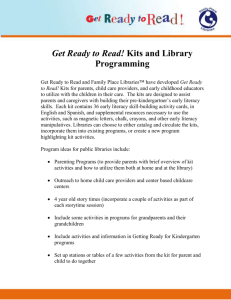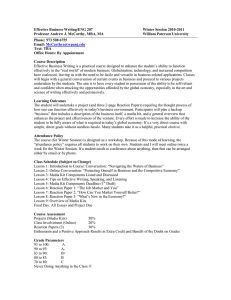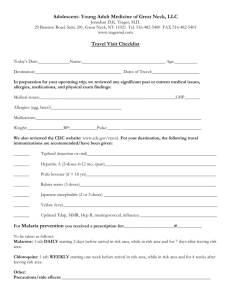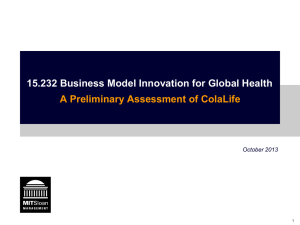ColaLife: Building Unlikely Alliances to Save Children’s Lives Oct 16, 2013 15.232
advertisement
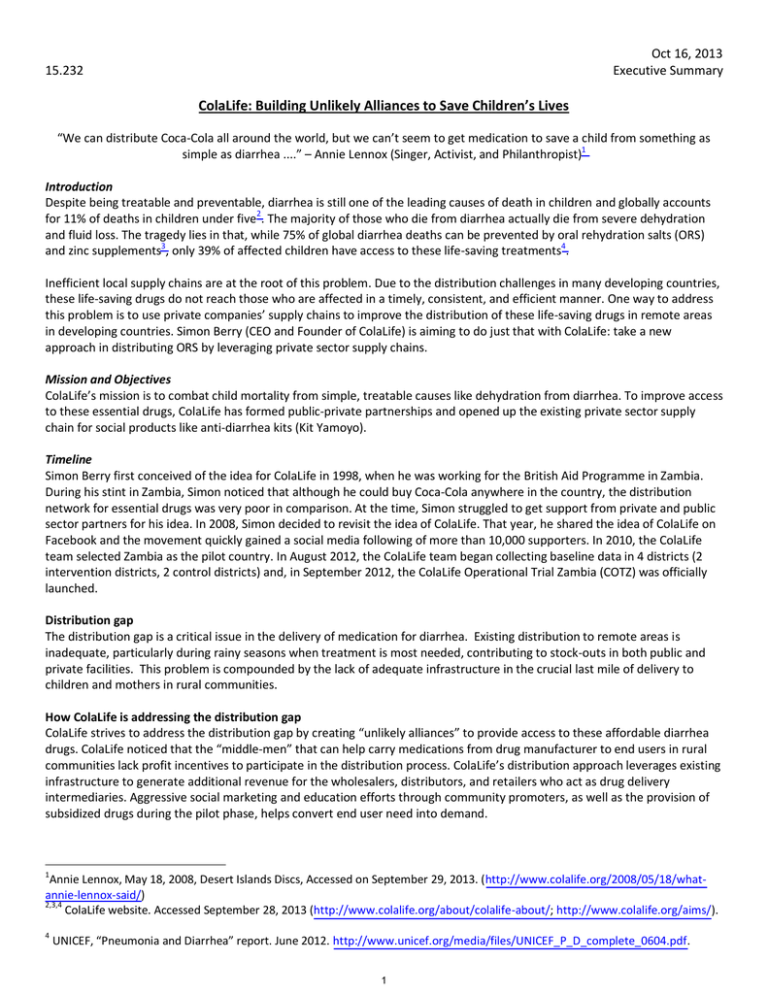
Oct 16, 2013 Executive Summary 15.232 ColaLife: Building Unlikely Alliances to Save Children’s Lives “We can distribute Coca-Cola all around the world, but we can’t seem to get medication to save a child from something as simple as diarrhea ....” – Annie Lennox (Singer, Activist, and Philanthropist)1 Introduction Despite being treatable and preventable, diarrhea is still one of the leading causes of death in children and globally accounts for 11% of deaths in children under five2. The majority of those who die from diarrhea actually die from severe dehydration and fluid loss. The tragedy lies in that, while 75% of global diarrhea deaths can be prevented by oral rehydration salts (ORS) and zinc supplements3, only 39% of affected children have access to these life-saving treatments4. Inefficient local supply chains are at the root of this problem. Due to the distribution challenges in many developing countries, these life-saving drugs do not reach those who are affected in a timely, consistent, and efficient manner. One way to address this problem is to use private companies’ supply chains to improve the distribution of these life-saving drugs in remote areas in developing countries. Simon Berry (CEO and Founder of ColaLife) is aiming to do just that with ColaLife: take a new approach in distributing ORS by leveraging private sector supply chains. Mission and Objectives ColaLife’s mission is to combat child mortality from simple, treatable causes like dehydration from diarrhea. To improve access to these essential drugs, ColaLife has formed public-private partnerships and opened up the existing private sector supply chain for social products like anti-diarrhea kits (Kit Yamoyo). Timeline Simon Berry first conceived of the idea for ColaLife in 1998, when he was working for the British Aid Programme in Zambia. During his stint in Zambia, Simon noticed that although he could buy Coca-Cola anywhere in the country, the distribution network for essential drugs was very poor in comparison. At the time, Simon struggled to get support from private and public sector partners for his idea. In 2008, Simon decided to revisit the idea of ColaLife. That year, he shared the idea of ColaLife on Facebook and the movement quickly gained a social media following of more than 10,000 supporters. In 2010, the ColaLife team selected Zambia as the pilot country. In August 2012, the ColaLife team began collecting baseline data in 4 districts (2 intervention districts, 2 control districts) and, in September 2012, the ColaLife Operational Trial Zambia (COTZ) was officially launched. Distribution gap The distribution gap is a critical issue in the delivery of medication for diarrhea. Existing distribution to remote areas is inadequate, particularly during rainy seasons when treatment is most needed, contributing to stock-outs in both public and private facilities. This problem is compounded by the lack of adequate infrastructure in the crucial last mile of delivery to children and mothers in rural communities. How ColaLife is addressing the distribution gap ColaLife strives to address the distribution gap by creating “unlikely alliances” to provide access to these affordable diarrhea drugs. ColaLife noticed that the “middle-men” that can help carry medications from drug manufacturer to end users in rural communities lack profit incentives to participate in the distribution process. ColaLife’s distribution approach leverages existing infrastructure to generate additional revenue for the wholesalers, distributors, and retailers who act as drug delivery intermediaries. Aggressive social marketing and education efforts through community promoters, as well as the provision of subsidized drugs during the pilot phase, helps convert end user need into demand. 1 Annie Lennox, May 18, 2008, Desert Islands Discs, Accessed on September 29, 2013. (http://www.colalife.org/2008/05/18/whatannie-lennox-said/) 2,3,4 ColaLife website. Accessed September 28, 2013 (http://www.colalife.org/about/colalife-about/; http://www.colalife.org/aims/). 4 UNICEF, “Pneumonia and Diarrhea” report. June 2012. http://www.unicef.org/media/files/UNICEF_P_D_complete_0604.pdf. 1 Oct 16, 2013 Executive Summary 15.232 Partners/Relationships Over the years, ColaLife has developed a network of supporters and partners that help ColaLife employees fund and manage the distribution process. Corporate funders such as Johnson & Johnson and Honda and aid organizations such as DFID provide much needed funding for COTZ. Packaging partner PI Global led the design process that helped turn the AidPod5 concept into a reality by creating an innovative anti-diarrhea kit that fit into the space between bottles in Coca-Cola crates. Medical Stores Limited (MSL), fully owned by the Zambian government, is a critical distribution partner that procures, packages, and distributes medication to districts. SAB Miller, the only Coca-Cola bottler in Zambia, liaises with wholesalers, and provides technical support on the value chain, as well as retailer training and marketing. Keepers Zambia Foundation (KZF) helps with community engagement and social marketing. ColaLife plans to work with private sector partners to scale the model after the pilot phase is completed. Core Strengths and Capabilities ColaLife has several core strengths and capabilities. First, the organization fills a unique role in global health by bringing together public and private sector stakeholders to combat child mortality associated with diarrhea. Second, ColaLife offers – at least in theory – a replicable, low-cost solution – supported by a lean organization that operates with little overhead and leverages existing infrastructure for distribution. Lastly, ColaLife fosters grassroots empowerment through a local ownership model – whereby retailers determine prices and quantities sold (e.g., retailers decide whether to distribute free, at cost, or with positive profit margins). Key Challenges and Implications Going forward, ColaLife faces several key challenges. First, operations currently depend on subsidies. The cost for COTZ, $1.35mm, is fully funded by corporations and aid organizations, and target consumers have been given vouchers to purchase their first anti-diarrhea Kit Yamoyo for free. Consumers who purchase their first Kit with the voucher receive a second voucher of 50% off their next Kit purchase on their mobile. To date, approximately 90% of the 24,565 kits have been purchased with vouchers and the remaining 10% have been purchased with cash.6 The revenue from Kit Yamoyo sales only covers a portion of their fixed and variable costs. If ColaLife continues to depend on subsidies to sell the product, then it will be difficult for the organization to scale and achieve long-term financial sustainability. Second, ColaLife’s idea to use Coca-Cola boxes for distribution has not been embraced by retailers. As a result, distribution to retailers has become more challenging than originally anticipated, widening the distribution gap. An easier, lower-cost approach to reaching these retailers needs to be developed. Third, while ColaLife engages in social marketing, there is low awareness of ColaLife’s products among target consumers. This translates into low demand for the Kit Yamoyo, which limits revenues and, by extension, struggles to deliver financial sustainability. Lastly, user compliance (with duration and dosage) presents a significant challenge. ColaLife currently does not have a way to ensure that consumers use the anti-diarrhea kits correctly. Non-compliant users compromise the product’s effectiveness, which, in turn, lowers outcomes and threatens ColaLife’s reputation. Recommendations We provide three recommendations for ColaLife. Firstly, to improve revenue generation, ColaLife could explore opportunities to increase revenue via advertising on the package, inside the Kit, or through SMS. ColaLife could also analyze users’ willingness to pay to identify optimal pricing for distinct user segments. Secondly, to reduce costs, ColaLife could identify new distribution partners and consider no- or low-cost ways to leverage their distribution networks directly. Thirdly, to generate greater awareness of ColaLife’s services and improve demand, ColaLife could engage end users in a direct sales model, encourage the distribution of information, or employ health workers to raise awareness in the communities. Vision for the Future Looking to the future, we envision that ColaLife should maintain its existing easy-to-use packaging and expand its distribution partnerships. We expect that demand will continue to increase through greater consumer awareness, increased incentives for distributors, and improved penetration to rural areas. Given the organization’s progress to date, we believe that ColaLife will achieve the scale it requires to reduce child mortality from diarrhea. 5 6 AidPods are wedge-shaped containers that ColaLife has used to package anti-diarrhea kits into Coca-Cola distribution boxes. Interview with Simon Berry, ColaLife Founder. 2 MIT OpenCourseWare http://ocw.mit.edu 15.232 Business Model Innovation: Global Health in Frontier Markets Fall 2013 For information about citing these materials or our Terms of Use, visit: http://ocw.mit.edu/terms.


